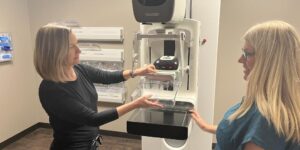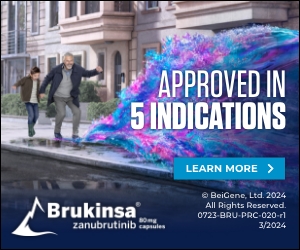
Mammography Technologist Jamie Steuber and Mammography Supervisor Virginia Minick demonstrate Oklahoma City VA Health Care System’s new state-of-the-art 3D mammography machine. Source: VA
PHILADELPHIA — Screening mammography plays a crucial role in identifying and treating breast cancer at its early stages, yet many women who could benefit from regular mammogram screenings don’t receive them.
Of the more than 280,000 individuals who are enrolled in health plans offered by the VHA and are eligible for breast cancer screening (BCS), for example, only 66% are up-to-date on screening. Research suggested the percentage might be even lower for other populations.
Researchers at the VA and other health systems trying to improve mammogram uptake are examining the effectiveness of approaches including online self-scheduling and opt-on, opt-out phone options. Two recent studies found one of these to work well and the other to be “burdensome.”
What Worked: Self-Scheduling Through Patient Portals
Traditionally, a scheduling a mammogram has required the patient to make a phone call during business hours and speak with office personal to find a mutually workable time.
A new study published in the American Journal of Preventive Medicine found that, when patients were given the option to schedule their own mammograms online, they tended to do so more often.1
Although most institutions have allowed patients to schedule primary care appointments online for some time, the ability to schedule procedures and diagnostic tests has lagged, said Kimberly Waddell, PhD, assistant professor at Penn Physical Medicine & Rehabilitation and lead author of the new study.
To determine how the ability to self-schedule mammogram appointments online affects mammogram uptake, Waddell and her colleagues used electronic health records data from the Penn Medicine Health System to examine and compare mammogram completion rates among patients with and with without electronic health record (EHR) portals. The retrospective study was based on data collected from 2014 to 2019—approximately two years before to three years after Penn’s self-scheduling function was implemented for screening mammograms.1
“We found that mammogram completion did significantly increase in the period after self-scheduling implementation,” Waddell told U.S. Medicine. “Overall, the completion rate went from 22% in the pre-period to 49% in the post period.”
When the researchers dug a little deeper, they found that, among those who had a portal account, there was 13.2% increase in mammogram completion compared to those who did not have an EHR portal. “The second finding that I thought was really interesting was that, when we looked at those who received an order for a mammogram at their eligible visit, there was a 14.7% increase in mammogram completion over those who did not have an EHR portal but who had also received an order for a mammogram.”
Waddell, who also has an appointment as a research scientist at the VA Center for Health Equity Research and Promotion, said the biggest implication of this work is that ease of scheduling can increase mammogram appointments. “Just making it a little easier can really have a sizable income on mammogram completion,” she said.
Automated Opt-Out vs. Opt-In Outreach Strategy: An Administrative Burden
While the use of online self-scheduling was shown to increase mammogram appointments, a study of an automated opt-out vs. opt-In outreach strategy had less positive results.
The field of behavioral medicine tells us that, when given a choice of options, will choose the default option—the one that was preselected. Opt-out initiatives, wherein services are automatically offered unless explicitly refused, have demonstrated efficacy in boosting vaccination and cancer screening rates when contrasted with opt-in methods. Nevertheless, the comparative effectiveness of opt-out and opt-in strategies for BCS outreach within the VHA had been unexplored.
To determine if an opt-out initiative might be a way to increase mammogram uptake, researchers randomized 883 of women due for mammogram screenings at the VA Puget Sound Health Care System in Seattle into two groups.2
The opt-in group, which consisted of 442 patients, received an automated call offering 3 choices: receive a referral for a mammogram, talk to their primary care clinician about breast cancer screening or decline a mammogram. If they chose the mammogram referral, a nurse made the referral, and they were contacted by phone to schedule. In the opt-out scenario, 441 patients had their medical records reviewed by a nurse, a mammogram referral was made, and they were contacted by phone to schedule.
While there were more referrals in the opt-out group than the opt-in group, there were also more cancellations (104 [23.6%] vs. 24 [5.4%]). The restricted analysis demonstrated similar results, except more veterans completed or scheduled mammography within 100 days in the opt-out group compared with the opt-in group (102 of 388 [26.3%] vs. 80 of 415 [19.3%]). Yet the opt-out approach did not result in a significant difference in mammography completion, the authors stated.
The authors admitted their study had some limitations, including inadequate nursing staff time to conduct medical reviews for veterans who didn’t opt for breast screening in the opt-in group. This resulted in more exclusions from the opt-out group compared to the opt-in group in the limited analysis. Furthermore, the opt-out group didn’t receive a preliminary message before the scheduling call, potentially impacting the effectiveness of the intervention.
“The administrative burden of the opt-out approach, including medical record review of all veterans prior to outreach to confirm BCS eligibility, at least 1 telephone call to eligible veterans, and an increased number of canceled referrals following outreach, likely outweighs any potential added benefit,” the authors wrote in JAMA Internal Medicine. Therefore, a comparable result for opt-in, a less burdensome outreach approach, may be valuable to VA operational leaders interested in a population-based BCS outreach, they concluded.
- Waddell, K. J., Goel, K., Park, S. H., Linn, K. A., et al. (2024). Association of Electronic Self-Scheduling and Screening Mammogram Completion. American journal of preventive medicine, 66(3), 399–407. https://doi.org/10.1016/j.amepre.2023.11.002
- Marcotte, L. M., Deeds, S., Wheat, C., Gunnink, E., et al. (2023). Automated Opt-Out vs Opt-In Patient Outreach Strategies for Breast Cancer Screening: A Randomized Clinical Trial. JAMA internal medicine, 183(11), 1187–1194. https://doi.org/10.1001/jamainternmed.2023.4321

